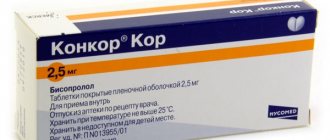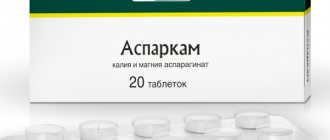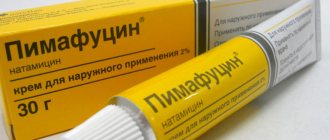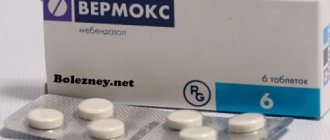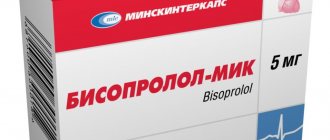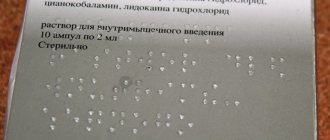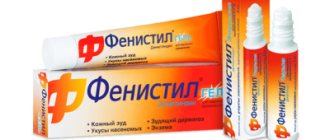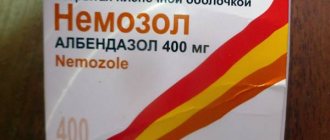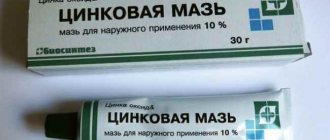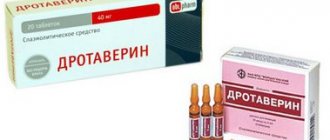Compound
When treating children, Zyrtec can be used in the form of tablets and drops for oral administration.
The drops are clear and have a faint vinegar odor. The volume of the solution in the bottle is 1 ml. It contains 10 mg of the active compound (cetirizine hydrochloride). The drops also contain purified water, sodium saccharinate, glycerol, propylparabenzene, acetic acid and other substances. Zirtec tablets are white and coated with a thin film coating. They are oblong, convex on both sides, and have engraving and scoring. 1 tablet contains 10 mg of medication. The tablets are placed in blisters and cardboard packs.
Each 10 mg tablet contains the active substance cetirizine dihydrochloride and auxiliary ingredients:
- 37 mg microcellulose;
- 66.4 mg lactose monohydrate;
- 0.6 mg colloidal silicon dioxide;
- 1.25 mg magnesium stearate.
The film shell consists of 1.078 mg of titanium dioxide, 2.156 mg of hypromellose and 3.45 mg of macrogol 400.
1 ml of drops contains the active ingredient in an amount of 10 mg and excipients:
- 250 mg glycerol;
- 350 mg propylene glycol;
- 10 mg sodium saccharinate;
- 1.35 mg methylparabenzene;
- 0.15 mg propylparabesol;
- 10 mg sodium acetate;
- 0.53 mg acetic acid;
- up to 1 ml of purified water.
The main active substance in the antihistamine drug is cetirizine, a metabolite of hydroxyzine. Its action is based on blocking histamine receptors during the development of a special immune response to an irritating factor. The antiallergic effect consists of facilitating the manifestation of reactions to allergens in the form of an antipruritic effect.
Cetirizine acts both in the early and late stages of allergy manifestations. It relieves the manifestations of tissue reactions and spasm from smooth muscles by reducing the level of capillary permeability and relieving swelling in adult patients. Excipients are silicon dioxide, lactose monohydrate, magnesium stearate, cellulose, methylparabenzene, propylene glycol, sodium acetate.
Recommendations for the use of Zirtrek and alcohol
In order not to provoke serious illnesses, it is better to refrain from mixing alcohol with the drug and take the medicine, observing the following time intervals:
- Men should stop taking the drug one day before drinking alcohol, and continue only 20 hours after removing the breakdown products of ethyl alcohol from the body.
- Women should stop taking tablets and drops two days before drinking alcohol and continue the day after.
It is better to avoid taking liquids containing alcohol for a month after completing a complex course of treatment with the drug, because the breakdown products of the chemical components of the drug remain in the liver for up to three weeks, and ethyl alcohol entering the liver does not cleanse it at all, but, on the contrary, destroys healthy cells.
Release form
The drug is available in two pharmacological forms:
- Film-coated tablets. These are white, oblong tablets with convex surfaces, with a score on one side and an engraved letter “Y” on both sides of the score. 7 or 10 tablets are placed in a blister; 1 blister (7 or 10 tablets each) or 2 blisters (10 tablets each) are placed in a cardboard box.
- Zyrtec drops. Externally it is a transparent liquid, without color. Characteristic odor of acetic acid. The liquid is poured into 10 or 20 ml bottles of dark glass, tightly sealed. In addition to the bottle, a dropper cap is placed in the cardboard box.
Zyrtec is available in two pharmacological forms: tablets and drops. The white tablets are oblong in shape, with bulges on the surface. There is a score on one side and a "Y" is engraved on either side of it. The plate consists of 7 or 10 tablets, the pack contains 1 plate (7 or 10 tablets) or 2 plates (10 tablets each).
pharmachologic effect
The drug has an antihistamine effect, so it is taken to get rid of allergies.
Zyrtec prevents the occurrence and relieves allergy symptoms, has antipruritic and antiexudative effects. Reduces the movement of eosinophils, neutrophils, basophils, stabilizes mast cell membranes. The product prevents the manifestation of skin reactions, urticaria. When taken in the correct dosage, it does not have a sedative effect and does not cause addiction. The effect of the drug begins in 20-60 minutes and lasts throughout the day. After completing the course of treatment, the effect lasts for about 3 days.
This allergy medicine affects the child’s body in the following ways:
- Blocks H1-histamine receptors. These are structures that are located in the membrane of cells of the heart, nervous system, vascular endothelium and smooth muscle and are responsible for inflammatory processes upon contact with an allergen.
- Reduces the production of inflammatory mediators (histamine).
- Reduces itching due to allergies.
- Facilitates the occurrence of allergic reactions.
- Reduces the migration of cells (basophils, neutrophils, eosinophils) in areas of inflammation.
- Reduces the permeability of small blood vessels, which helps reduce exudation (fluid release). This is important in the development of allergic rhinitis.
- Reduces spasm of smooth muscles.
- Reduces tissue swelling.
- Reduces skin reaction in cold urticaria.
- Reduces the likelihood of bronchospasm in asthma, making breathing easier.
Application
“Zyrtec” – drops for babies (the instructions fully confirm this), which are prescribed for the treatment of year-round and seasonal rhinitis, conjunctivitis, dermatitis caused by allergic irritants.
In addition, the remedy helps get rid of angioedema and urticaria, which occurs in acquired and idiopathic form.
The drug is used in the treatment of dermatoses that are accompanied by severe itching and rashes, hay fever, bronchial asthma, sneezing, watery eyes, and nasal congestion. Drops are prescribed to children over six months of age.
How to take Zyrtec drops
The dosage depends on the patient's age. The condition of the body is also taken into account, for example the presence and degree of renal failure.
In most cases, the daily dose is taken at one time. Directions for use: inside (for both forms).
The attending physician decides how many days to take the drug, taking into account the diagnosis and severity of the allergic reaction.
Dosage of the medicine in drops depending on age:
- adults and children over 6 years of age are prescribed 10 drops of the medicine as an initial dose, then, if necessary, it is increased to 20 drops;
- children under 6 years of age, but over 2 years of age, are advised to take 5 drops twice a day or 10 drops at a time;
- at the age of one to two years, take 5 drops 1-2 times a day;
- drops for children from six months to a year are prescribed in a dose of 5 drops;
- For patients with liver failure, the dosage is selected taking into account creatinine clearance. If it is a child, its weight is also taken into account when adjusting the dose.
The dosage of tablets is calculated as follows:
- adults and children over 6 years old - from half a tablet (initial dose), the dose can be increased to a tablet per day;
- Before 6 years of age, medicine in tablet form is not prescribed.
The summary of the drug provided by the manufacturer shows that only Zyrtec drops are used to treat pediatric patients. In this case, drops are dosed for children depending on age.
Dosage for children:
- 5 drops from 6 months to one year;
- 5 drops 1-2 times – from 1 to 2 years;
- 10 drops daily at a time or divided into two doses - from 2 to 6 years;
- Older children are prescribed the same dose as adults.
The way to take the drops for children is slightly different from the method for adults. Children can take the drops as syrup (orally, diluting a little with water), but up to one year, Zyrtec can be prescribed as nasal drops. In this case, they are instilled drop by drop into each nostril, after cleaning them first.
Treatment continues until allergy symptoms stop.
An overdose occurs when a single dose of medication is taken several times higher than the daily dosage.
If a higher than usual dose has been taken, you must immediately rinse the stomach or induce vomiting. You can also give activated carbon. There is no specific antidote, so only symptomatic treatment is possible. Hemodialysis in case of overdose is ineffective.
Zyrtec for children is used very widely. Reviews of Zyrtec drops for children show that if it is used as recommended in the instructions, the effect will be high and the risk of undesirable consequences will be minimal.
Zyrtec drops can be used with or without food. Food does not affect the effectiveness of the medicine. Children over 6 years old can be given 20 drops per day. The daily dose can be divided into 2 doses of 5 mg (10 drops). In some cases, the medicine is used in a reduced dosage (5 mg).
For sick children 2-6 years old, the drug is prescribed in a dosage of 2.5 mg (5 drops) twice a day or 5 mg once a day. At 1-2 years of age, Zyrtec is taken only twice a day, 2.5 mg. At the age of 6-12 months, 5 drops per day (2.5 mg) are prescribed. After opening the package, before taking the medicine, you should carefully read the instructions for use of Zyrtec.
The drug in the form of drops is not prescribed to children under six months of age (including newborns) due to the lack of data on the effect of the drug on their body. At an older age (after 6 months), the drug is prescribed according to indications.
Zyrtec for pregnant women
The medicine should not be used while carrying and feeding a child. The drug is especially dangerous in the 1st trimester, when the formation and formation of fetal organs and systems occurs. Uncontrolled use of Zyrtec during pregnancy can cause disruption of embryogenesis and complications. An antihistamine should only be used in emergency cases (anaphylaxis). In case of allergic pathology, it is recommended to replace Zyrtec with other medications or completely refrain from taking medications.
In case of renal failure in adults, the daily dose is adjusted. It is determined by the level of creatinine clearance. To obtain this indicator in men, the difference between 140 years and the patient's age in years is multiplied by weight, divided by 72 and multiplied by the concentration of serum creatinine in the blood (this is a product of nitrogen metabolism). For women, the resulting value is multiplied by a factor of 0.85.
In case of mild renal failure (clearance 50-79 ml/min), the daily dose is not reduced. For creatinine clearance (creatinine clearance) from 30 to 49 ml/min (corresponding to moderate renal failure), the dosage is 5 mg/day. When CC is below 30 ml/min, Zyrtec should be taken 5 mg every other day. At the terminal stage of the disease, the medicine is contraindicated.
Signs of an overdose appear if a person takes more than 50 mg of the drug at a time. The following symptoms are possible:
- diarrhea;
- fatigue;
- headache;
- lethargy;
- mydriasis (increased pupil diameter);
- drowsiness (appears as a result of increased sedation);
- acute urinary retention;
- trembling in the limbs;
- stupor;
- general malaise;
- acceleration of heart rate.
Treatment for overdose includes stopping the drug, using symptomatic medications, flushing the stomach with plenty of water, or inducing vomiting. Patients are prescribed sorbents (activated carbon, Polysorb MP or Polyphepan), as for mercury poisoning.
Children should take Zyrtec drops for allergy symptoms according to a clearly designated regimen. The dosage and schedule of administration depends on the age of the child. How to take Zyrtec drops for children is indicated in the instructions:
- babies aged 6-12 months – 5 drops 1 time per day;
- for a child aged 1-2 years – 5 drops 2 times a day;
- baby 2-6 years old – 5 drops 2 times a day;
- for children over 6 years of age and adults – 10-20 drops once a day.
The instructions indicate that the dose of the drug prescribed by the doctor can be diluted with a small amount of clean water. For children over 6 years old, drops can be replaced with tablets. The duration of the course is determined by the allergist individually for each child. Self-administration of the drug is possible only when the baby needs immediate emergency care.
For newborns
The dosage and duration of treatment are determined by doctors based on the complexity of the particular case and the characteristics of the baby’s body. Despite all the restrictions, Zyrtec is still used for newborns, but only under the strict supervision of the attending physician. To prevent side effects, it is better to instill Zyrtec into the nose for infants up to 6 months rather than add it to breast milk.
When using for the first time, you need to drop one drop to make sure there is no allergy to the components of the medicine. Doctors advise to be as careful as possible when treating younger children with this drug, because it can depress the fragile central nervous system and cause respiratory arrest. Regular monitoring of the baby's heart rate is required, and if there are any unclear symptoms, it is recommended to consult a doctor.
Before or after meals
Zyrtec is a universal drug, because its quality of absorption into the body does not depend on the time of food intake. To get the fastest possible results, it is recommended to take the medicine on an empty stomach, but if you use it regularly, it is better to take the medicine after meals, this will protect the stomach from unnecessary stress. The concentration of the product will be sufficient to prevent allergic manifestations.
Doctors prescribe the duration of medication use based on what is causing the allergic reaction. In the absence of contraindications, a doctor’s prescription allows the drug to be given to infants for urgent symptom relief. The number of drops must be counted with caution, strictly according to the instructions. On average, in the presence of acute allergic reactions, the drug is taken for 7-10 days.
A small number of people taking Zyrtec experience side effects. The main possible adverse reactions include:
- headache;
- dizziness;
- drowsiness;
- fatigue;
- nausea.
Less commonly found:
- convulsions;
- disturbances in the gastrointestinal tract;
- weight gain;
- skin rashes.
If you are intolerant to any of the components of the drug, anaphylactic shock may develop. An overdose can occur with a single dose exceeding 50 mg. In this case, mental confusion, tremors, urinary retention, diarrhea, and weakness occur. Emergency care consists of inducing a gag reflex and using enterosorbents.
Pharmacodynamics and pharmacokinetics
Pharmacodynamics
Cetirizine, the active ingredient in Zyrtec, is a competitive histamine antagonist. Its effect is due to its ability to block H1 histamine receptors.
Clinical manifestations of cetirizine:
- itching is relieved;
- the amount of exudate decreases;
- the rate of migration of blood cells, which are characterized by participation in allergic reactions (eosinophils, neutrophils and basophils), decreases;
- the membranes of mast cells are stabilized;
- the permeability of small vessels decreases;
- spasms of smooth muscles are relieved;
- tissue swelling is prevented;
- the skin reaction to certain allergens is eliminated (with the introduction of specific antigens or histamine, cooling the skin);
- in mild stages of bronchial asthma, the severity of histamine-induced bronchoconstriction decreases.
Pharmacokinetics
After the drug is taken orally, it is quickly absorbed from the digestive tract into the blood and is approximately 93% bound to plasma proteins. When consumed simultaneously with food, the absorption rate becomes lower, but the volume of absorbed substance does not change.
The effect appears 20-60 minutes after a single dose and lasts more than a day. Maximum plasma concentration is achieved 1-1.5 hours after administration.
Metabolism occurs through O-dealkylation. The resulting metabolite has no pharmacological activity.
The half-life from the body depends on age:
- in adults it lasts 10 hours;
- for children 6-12 years old – 6 hours;
- at the age of 2-6 years – 5 hours;
- in children from six months to 2 years – 3.1 hours.
2/3 of the dose that was taken is excreted unchanged through the kidneys. The liver also plays a significant role in the elimination of the drug. Therefore, in case of chronic liver diseases, the half-life increases by one and a half times, and in case of moderate renal failure - by 3 times.
Cetirizine is a histamine antagonist produced in mast cells. The drug does not disrupt the interaction of cell receptors with the neurotransmitter acetylcholine. Also, the medicine does not affect the effects of the mediator serotonin. When using Zyrtec in a therapeutic dose, there is no sedative effect.
When taking 1 ml of drops, the effect occurs within 20-60 minutes and lasts up to 24 hours. Addiction does not occur with prolonged use of the medicine. After finishing taking the drops, the effect of the drug continues for another 3 days.
The active substance is well absorbed by the gastric and intestinal mucosa. Eating food does not affect the absorption of the medicine. After entering the bloodstream, the medication interacts with blood plasma proteins. Cumulation (accumulation) is not typical for this drug.
Metabolism (transformation of a substance) occurs mainly in the liver. This process occurs in the presence of cytochrome P450. The elimination period of cetirizine in children 6-12 years old is 6 hours. At a younger age, this figure is 3-5 hours. The drug is excreted primarily by the kidneys and urine. Cetirizine cannot be removed from the body by hemodialysis (blood purification).
Contraindications
The drug is prescribed with caution in the following conditions:
- moderate chronic renal failure;
- advanced age;
- epilepsy, increased convulsive readiness;
- the presence of factors predisposing to urinary retention.
Additional contraindications for Zyrtec tablets:
- galactose intolerance;
- malabsorption syndrome, in particular glucose-galactose;
- age under 6 years.
Indications for taking Zyrtec by children are:
- seasonal exacerbation of allergic rhinitis (inflammation of the nasal mucosa that occurs upon contact with allergens of plant, microbial or animal origin);
- year-round rhinitis of an allergic nature;
- hay fever (pollen allergy, hay fever);
- conjunctivitis (inflammatory disease of the conjunctiva of the eyes);
- idiopathic urticaria (unspecified etiology);
- chronic urticaria;
- Quincke's edema (an acute allergic condition characterized by swelling of the skin and subcutaneous tissue, mainly of the upper body);
- atopic dermatitis;
- dermatoses;
- itching due to skin diseases.
Zyrtec drops for oral administration are not used for the following conditions:
- Creatinine clearance less than 10 ml/min (severe renal failure).
- Carrying a child.
- Individual intolerance to the components of the drug.
- Galactose intolerance.
- Malabsorption syndrome (insufficient absorption of substances in the small intestine).
- Insufficient synthesis of the lactase enzyme in the body (lactase deficiency).
- Increased sensitivity of the body to hydroxydine.
- Breastfeeding.
Zyrtec for adults and children should be prescribed with caution if there is a history of chronic renal failure and liver pathology (tumors, cirrhosis, hepatitis, hepatosis).
Like all medicines, Zyrtec has its contraindications for use. They vary depending on the form of release of the product used. Tablets are contraindicated for use in the presence of galactose intolerance, lactase deficiency and malabsorption syndrome. Their use is not recommended for children under 6 years of age. Drops should not be used by children under 6 months unless absolutely necessary. Taking the drug in any form is contraindicated if:
- hypersensitivity to the components of the drug;
- renal failure and other kidney diseases;
- pregnancy and lactation.
Reviews from doctors
Elena Potemkina, allergist
Zyrtec drops are a quick and effective remedy that is convenient to give to children. It has a sweet taste, is consumed sparingly and is well tolerated by patients. I often prescribe it to treat allergies in children.
Olga Iskorostinskaya, gynecologist
A good antiallergic drug. The positive effect comes quite quickly. In moderate dosages it has almost no sedative effect. I prescribe the drug for itchy dermatoses and allergies. I recommend that all allergy sufferers buy Zyrtec and keep it in their home medicine cabinet.
Alexey Zinchenko, ENT
The drug has anti-edematous and anti-allergic effects. Zyrtec is easy to use because it comes in 2 forms: tablets and children's drops. The price of the medicine corresponds to the quality. I often use it to treat allergic rhinitis in combination with the nasal drug Nasonex.
Maria Langenbraun, cosmetologist
I consider Zyrtec drops to be a modern and highly effective drug. I prescribe it to people with allergic dermatoses, urticaria, itching and other unpleasant symptoms. During 3 years of medical practice, no side effects were observed.
Anastasia Volkova, dermatologist
An easy-to-use and effective drug for treating both adults and children. Despite the fact that Zyrtec is not the cheapest option for an antihistamine, the price is justified by the quality and rapid onset of clinical effect. I use it to treat atopic dermatitis in children and relieve symptoms of food allergies.
Before vaccination
Zyrtec is in many cases prescribed as a prophylactic before vaccinations. This is necessary to prevent any allergic reaction of the baby’s body to the vaccine. Such actions are critically perceived by some specialists, because the allergic reaction after taking the drug becomes implicit, which will complicate the interpretation of the results by a doctor. Sometimes doctors prescribe it to infants before surgical interventions, for example, to remove adenoids.
Some therapists still prescribe Zyrtec (or Fenistil), especially if the newborn suffers from allergies. The decision on whether or not to use the drug is made by parents, together with an immunologist and pediatrician. When a child has a runny nose, Zyrtec can eliminate the symptoms of an allergic disease and improve the condition of the little patient, but it is not able to immediately cure the disease. Therefore, the child’s body needs to be examined to draw up the required course of treatment.
Features of drug treatment
Reviews from patients claim that the medicine rarely causes side effects and complications.
The drug is used exclusively until the symptoms of an allergic reaction disappear, therefore, you should not just use the drug for the sake of prevention (or for the sake of prevention). Typically, the course of treatment with Zirtrek is about 7 days, but can reach 10, with particularly severe inflammation of histamine receptors.
Seasonal allergies are suppressed through daily use of the medicine for 25-30 days. After the course of treatment, you must take a break for 2-3 weeks and only after that you are allowed to take Zirtrek.
- Drops can be diluted in any container and washed down with plenty of water due to the unpleasant taste and smell of the medicine.
- The tablets are taken with plenty of water.
With long-term use of Zirtrek, its effect on histamine receptors does not decrease, because the drug is not addictive.
Side effects
Side effects of Zyrtec can be divided into those that occur often (at least 1 in 10 people taking the medicine), common (1 in 10-100), uncommon (1 in 100-1000), rare (1 in 1000- 10,000), very rare (less than one in 10,000).
The following undesirable effects occur infrequently:
- paresthesia;
- mental excitement;
- diarrhea;
- abdominal pain;
- skin rash, itching;
- asthenia.
Undesirable effects that are rare:
- peripheral edema;
- hives;
- increased levels of functional liver tests (activity of transaminases, alkaline phosphatase, bilirubin concentration);
- weight gain;
- tachycardia;
- confusion, hallucinations;
- aggression;
- depression;
- sleep disorders;
- convulsions;
- hypersensitivity reactions.
The following reactions may also occur (no data on how common they occur):
- increased appetite;
- urinary retention;
- vertigo;
- suicidal ideas;
- memory impairment, even before amnesia.
Most patients tolerate Zyrtec well. Sometimes the following undesirable reactions occur when taking the medicine:
- Impaired functioning of the cardiovascular system in the form of tachycardia (frequent heartbeat, more than 80 beats/min).
- Visual disturbances (decreased visual acuity, blurred objects, chaotic movements towards the eyeballs, impaired accommodation).
- Respiratory disorders (nasal discharge and congestion, sore throat and sore throat). Pharyngitis (inflammation of the pharynx) and rhinitis often develop.
- Dyspepsia (pain in the upper abdomen, frequent loose stools, nausea).
- Dryness of the oral mucosa.
- Increased levels of liver enzymes (alkaline phosphatase, ALT, AST) and bilirubin. It is detected during a biochemical blood test.
- Dysuric disorders. Enuresis (nighttime, involuntary urination) is possible in children. In adults - nighttime and frequent daytime urination.
- Weight gain.
- Allergies (urticaria, itching, exanthema, angioedema, anaphylactic shock).
- Asthenia (fatigue at work, weakness, daytime sleepiness, decreased productivity, decreased academic performance of children).
- General malaise.
- Edema.
Neurological disorders (impaired sensitivity in the form of goosebumps, burning and tingling of the skin, coordination disorders, convulsions, dizziness, hallucinations, depression, aggression, increased excitability, drowsiness, dystonia, headache, nervous tics). Fainting and tremors of the limbs are sometimes observed.
Drug interactions
Interaction of Zyrtec with other drugs:
- with Thiophylline – the total clearance of cetirizine decreases by 16%;
- with Ritonavir - the AUC of cetirizine increases by 40%, and Ritanovir decreases by 11%;
- with Zopiclone, Bupreporfin - mutually enhance each other’s effect, which manifests itself in central nervous system depression;
- with Diazepam - mutually enhance the effect on the nervous system, as a result of which its functioning worsens and the reaction rate decreases.
The interaction of Zyrtec with pseudoephedrine, cimetidine, erythromycin, azithromycin, glipizide, diazepam was studied - no undesirable interactions were found. With simultaneous therapy with theophylline-containing drugs, the rate of elimination of cetirizine from the body is reduced by 16%. It is recommended to refrain from drinking alcohol during treatment to avoid depression of the nervous system.
General concept of analogues
Analogues are medicines with identical compositions, differing in that one medicine is patented, the manufacturer of which is the parent company, and the rest are called generics.
Analogs and patent-protected medicines have the same composition, do not differ in effectiveness from medicines protected by patent law, but are noticeably inferior in price.
Manufacturers of high-quality analogues research and compare the effectiveness and safety of a patented medicine and its substitute.
Many people incorrectly believe that analogues are medications with the same effect. There are many remedies for allergies, but they cannot be called analogues of each other due to the difference in composition and the different effects they have on the patient.
Article on the topic: Zodak for allergies: instructions and analogues for children
Zyrtec and its analogues for children
special instructions
This medication does not affect a person’s psychomotor reactions and does not cause drowsiness, so it can be taken without worrying about changing your usual routine. You should be especially careful about dosages, because a single dose of more than 50 mg can cause an overdose. Particular attention should be paid to taking the drug along with theophylline. This information was obtained through numerous studies.
Particular caution should be exercised when prescribing the drug to persons with factors predisposing to urinary retention (spinal cord damage, prostatic hyperplasia), since cetirizine increases the likelihood of this complication.
During treatment, it is advised to avoid driving and activities that require high concentration and high reaction speed.
The drug should not be prescribed to children under one year of age who are at high risk of developing sudden death syndrome (sleep apnea syndrome, mother or nanny smoking, premature babies, etc.).
Overdose of Zyrtec®
Symptoms of overdose : when taking the drug in a single dose of more than 50 mg, confusion, diarrhea and diarrhea, dizziness, increased fatigue, mild headache, malaise, mydriasis, itching, muscle weakness, sedation, drowsiness, stupor, tachycardia, tremor, are possible. urinary retention.
Treatment for overdose : gastric lavage should be performed immediately or artificially induce vomiting. Take activated charcoal and carry out symptomatic and supportive therapy. There is no antidote to the medicine. Hemodialysis is ineffective.
Zyrtec price, where to buy
| Release form of Zyrtec | Cost, rubles |
| 10 mg tablets No. 7 | 215 |
| 1% drops 10 ml | 350 |
| 10 mg tablets No. 20 | 450 |
You can buy medicine for adults and children at almost any pharmacy. The cost depends on the form of release. The price of Zyrtec tablets in Russian pharmacies is 160-192 rubles. The price of Zyrtec in drops is 270-300 rubles. The price of Zyrtec in Ukraine for tablets is approximately 260 UAH, and drops cost 300-350 UAH.
- Online pharmacies in RussiaRussia
- Online pharmacies in KazakhstanKazakhstan
ZdravCity
- Zyrtec tab. p.o 10 mg n20UCB Farchim SA/ Eisika Pharmaceuticals S.r.l.
Pharmacy Dialogue
Europharm* 4% discount using promo code medside11
- Zyrtec drops 10 mlUSB Farshim S.A./Eisika Pharmasuit
- Zirtec 10 mg No. 7 tabUSB Farshim SA/Eisika Pharmaceutical
- Zirtek 10 mg No. 20 tabletUSBFarshim SA,
show more
Zirtec instructions for use (abstract) tablets in photographs
photo of instructions for use of ZIRTEK 10 mg tablets, part 1
photo of instructions for use of ZIRTEK 10 mg tablets, part 2
photo of instructions for use of ZIRTEK 10 mg tablets, part 3
photo of instructions for use of ZIRTEK 10 mg tablets, part 4
